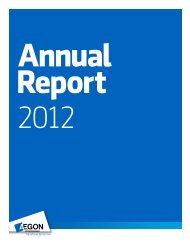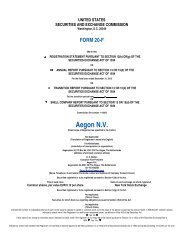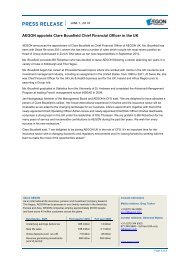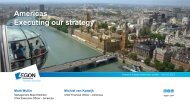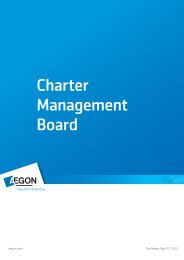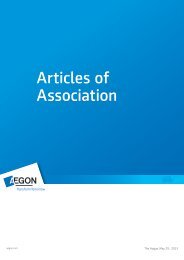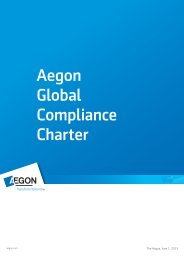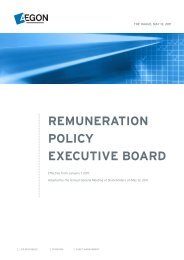Supplemental offering circular EUR 450,000,000 perpetual ... - Aegon
Supplemental offering circular EUR 450,000,000 perpetual ... - Aegon
Supplemental offering circular EUR 450,000,000 perpetual ... - Aegon
You also want an ePaper? Increase the reach of your titles
YUMPU automatically turns print PDFs into web optimized ePapers that Google loves.
Capital base<br />
AEGON applies leverage tolerances to its capital base. The capital base reflects the capital employed in core<br />
activities and consists of shareholders’ equity, capital securities and dated subordinated and senior debt.<br />
AEGON seeks to manage its capital base to comprise at least 70% shareholders’ equity, between 5% and<br />
15% capital securities, and a maximum of 25% dated subordinated and senior debt. At December 31, 2003,<br />
AEGON’s leverage was within these prescribed tolerances: equity capital represented 71% of its total capital<br />
base, while senior and dated subordinated debt comprised 19% of its total capital base. Capital securities<br />
accounted for the remaining 10%. The ratio of shareholders’ equity to total capital remains stable at<br />
approximately the same level as it was at year-end 2002.<br />
AEGON manages currency risk related to its capital base using established currency risk policies. Capital<br />
employed in operating subsidiaries required to satisfy (local) regulatory and self-imposed capital<br />
requirements is kept in local currencies and is subject to currency movements when translated into euro for<br />
reporting purposes. The non-equity components of AEGON’s capital base are held in or swapped into<br />
various currencies proportionally to the value of AEGON’s activities in those currencies. Although<br />
AEGON’s debt-to-total-capital ratio is accordingly not materially affected by currency volatility, currency<br />
fluctuations may affect the level of the capital base as a result of translation into euro.<br />
Shareholders’ equity<br />
Shareholders’ equity was <strong>EUR</strong> 14,132 million at December 31, 2003, compared to <strong>EUR</strong> 14,231 million at<br />
December 31, 2002. The decrease of <strong>EUR</strong> 99 million was largely due to the negative currency exchange rate<br />
difference of <strong>EUR</strong> 1,779 million (primarily resulting from the decline in the value of the US dollar compared<br />
to the euro), offset by net income of <strong>EUR</strong> 1,793 million before distribution of both preferred and common<br />
dividends. Goodwill charges of <strong>EUR</strong> 358 million, mainly as a result of the consolidation of the Meeùs Groep<br />
in the Netherlands, were largely offset by the gain on the sale of TFC’s real estate tax services and flood<br />
hazard certification business units.<br />
Debt funding and liquidity<br />
AEGON’s funding strategy continues to be based on assuring excellent access to international capital<br />
markets at low costs. As part of this strategy, AEGON aims to offer debt securities in amounts that are<br />
eligible for inclusion in major capital market indices and supports maintenance of liquid secondary markets<br />
in these securities by the banking community. This focus on the institutional fixed income investor base will<br />
continue to be supported by an active investor relations program to keep investors well informed about<br />
AEGON’s strategy and results.<br />
Most of AEGON’s external debt is issued by the parent company, AEGON N.V., as well as two companies<br />
whose securities are guaranteed by AEGON N.V.<br />
AEGON N.V. has employed its regular access to the capital markets through private placements issued under<br />
its USD 6 billion Euro Medium Term Notes Program and under separate US shelf registrations. AEGON’s<br />
USD 2 billion Euro Commercial Paper Program and AEGON Funding Corp.’s USD 4.5 billion Euro<br />
Commercial Paper Program facilitate access to international and domestic money markets, when required.<br />
Additionally, AEGON utilizes a USD 300 million US Domestic Commercial Paper Program. AEGON<br />
maintains back-up credit facilities to support outstanding amounts under its Commercial Paper programs. Its<br />
committed credit facilities, provided by banks with strong credit quality, exceed USD 3 billion. In addition<br />
AEGON has access to various credit lines.<br />
Internal sources of liquidity include distributions from operating subsidiaries on the basis of excess capital<br />
or cash and cash equivalents. Internal distributions may be subject to (local) regulatory requirements. Each<br />
business unit further manages its liquidity through closely managing the liquidity of its investment portfolio.<br />
AEGON uses common derivative financial instruments such as swaps, options, futures and cross-currency<br />
derivatives to hedge against its exposures related to external borrowings. In general, the accounting<br />
treatment of the derivative mirrors the accounting treatment of the underlying financial instrument.<br />
20



